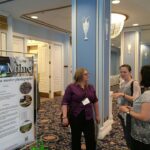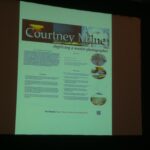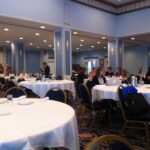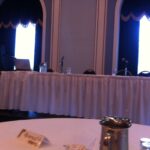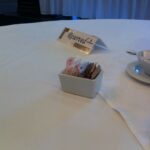Anyone who loves books and lives in Saskatchewan is bound to have read, or at least heard of the detective fiction of Regina-based author Gail Bowen. On the first morning of the conference the plenary was delivered by this mistress of intrigue who, true to form, kept the ballroom spellbound with her tales of serendipity, working with archives, and meeting royalty.
I think her best line (and twitter seemed to agree) was the notion that “archivists are alchemists.” Aside from the obvious ways in which this analogy would resonate with a group of document-loving history buffs, it was adept in its comparison between the disorganized haystack that our documents often arrive in, and the golden order we transmute them into. It is often the task of the archival worker to take what seems like an impossible mess of highly valuable research materials, and convert it into something that will be clean, tidy, well-documented, and–above-all–accessible to researchers.
 Heavily present in Gail’s talk was the notion of serendipity–a sort of stumble-across-good-luck which has, she claimed, played a huge role in her life and in her writing. She gave as an example the first book to which she had been invited to contribute: The Easterners’ Guide to Western Canada / The Westerners’ Guide to Eastern Canada (1985). A random request from a friend to write a small chapter in a little-known “airplane book” sparked a writing career that would span three decades and over twenty novels. (Interestingly, I myself had serendipitously found this book in our holdings a few months back and enjoyed a few moments reading Bowen’s segment “A Letter from British Columbia.”) In many ways, Bowen credits the success of her career to serendipity. The right person standing by the right fax machine at the right time has culminated in the adaptation of her novels into movies ; the right people becoming interested in the right play has led to her taking lunch with Prince Charles (who, as it turns out, isn’t much a fan of lunch–in Gail’s words “Clean your plate, boy!”).
Heavily present in Gail’s talk was the notion of serendipity–a sort of stumble-across-good-luck which has, she claimed, played a huge role in her life and in her writing. She gave as an example the first book to which she had been invited to contribute: The Easterners’ Guide to Western Canada / The Westerners’ Guide to Eastern Canada (1985). A random request from a friend to write a small chapter in a little-known “airplane book” sparked a writing career that would span three decades and over twenty novels. (Interestingly, I myself had serendipitously found this book in our holdings a few months back and enjoyed a few moments reading Bowen’s segment “A Letter from British Columbia.”) In many ways, Bowen credits the success of her career to serendipity. The right person standing by the right fax machine at the right time has culminated in the adaptation of her novels into movies ; the right people becoming interested in the right play has led to her taking lunch with Prince Charles (who, as it turns out, isn’t much a fan of lunch–in Gail’s words “Clean your plate, boy!”).
Bowen’s focus on the power of serendipity was interesting given the loaded nature of the term within archives and libraries, and perhaps an unintentional nod to a major topic of discussion in information theory. In a recent C-EBLIP article, Frank Winter discusses the (perceived) conflict between the desire to maintain serendipitous information discovery (as by reading shelves) and the need for more efficient resource allocation in the academic library (as by moving resources off-site to provide better student study spaces, or relying upon electronic copies) (Winter, 2015).
The struggle to allow for serendipitous discovery in any type of research in which the user is not handling the material from shelf-to-table is a familiar one in the world of archives and special collections. Archives and special collections, being spaces where the bulk of information is kept behind locked (or at least heavy) doors may seem singularly unsuited to the coincidental uncovering of information–however, this is not the case. Serendipity can and frequently does occur within the archival context. In her 2011 essay “Serendipity in the Archive,” Nancy Lusignan Schultz names two elements essential to fostering serendipity in archival research : “good sleuthing” on the part of the researcher (Bowen would love that) and “the expert guidance of a willing archivist” (Schultz, 2011). Here, the reference assistant must become an active accessory to serendipity–providing the user not just with what they ask for, but with a few shots in the dark besides.
Serendipity, then, takes a different form in archives and special collections than it does within the library stacks, being reliant not only on the keen eyes of the user as she rifles through files, but also upon the initial decision made by reference staff regarding which finding aids she may find on-topic. The reference staff must have a broad enough understanding of the unit’s holdings to provide guidance, yet be unfamiliar enough with the specific contents of each fonds to allow coincidental discoveries to occur. In many ways, each file within an archival fonds presents an ideal vehicle for serendipitous discovery, as its contents can be as varied as the interests of the person that created it.
In his article, Winter acknowledges the value of serendipity in research, but ultimately concludes that there are “so many variables that determine whether a user stumbles across something relevant that they are almost impossible to identify,” and therefore serendipity should perhaps not be invoked as an “operating principle when deciding how to manage down print collections” (Winter, 2015). His assertion about the nature of serendipity is in line with the vast difference between the kind of serendipitous discovery we see in the library stacks, and that which is found in archives and special collections. Serendipity is the result of a near-infinite chain of coincidences, and therefore can take a on near-infinite number of forms. Perhaps with the changing library landscape will come a shifting in the nature of serendipitous discovery in libraries themselves. As print collections shrink and move, we may lose the thrill of being accidentally (and literally) struck with a relevant top-shelf book as we reach for another. The question is, what other form of coincidental discovery will take its place?
Bowen, Gail. “25 Years of Writing Joanne.” ACA 2015 “Perspectives on the Archival Horizon”.
(June 11, 2015).
Schultz, Nancy Lusignan. “Serendipity in the Archive.” The Chronicle of Higher Education 57.37 (2011). Canadian Periodicals Index Quarterly. Web. 17 June 2015.
Winter, Frank. “Serendipity, Algorithms, and Managing Down the Collective Print Collection.” Brain Work. (March 2015). Last accessed: 17 June 2015.

